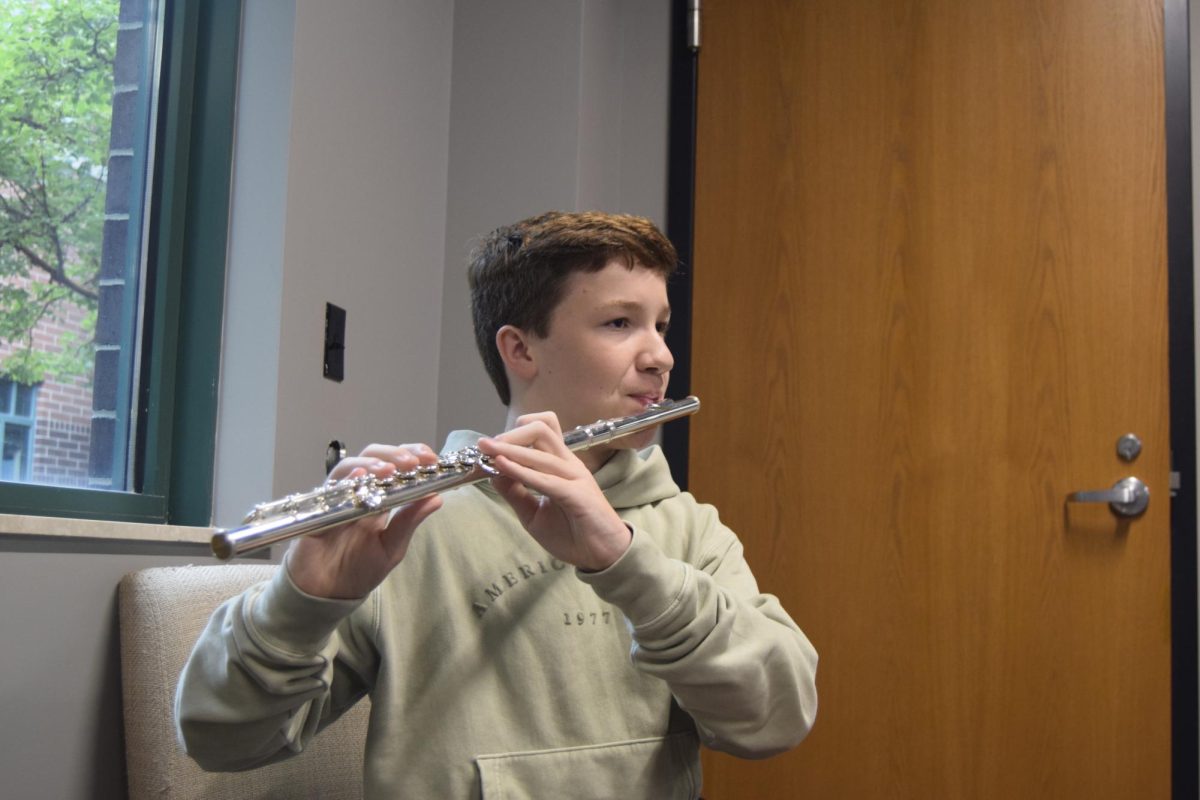The aisles of a grocery store are filled with packaged foods of all sorts. Chips, candies, and canned fruit are displayed on shelves as far as the eye can see. The norm of grocery shopping is to collect food to set on the dinner table while not necessarily paying much mind to nutritional values. However, what really lies in the ingredients of what we buy remains a mystery for many individuals in America when consumers are left picking packaged foods up without the conscious awareness of what’s in them.
Not only are poor nutritional values a leading cause in the depleting health of American citizens, but there’s also various food additives, sugar-filled drinks (like energy drinks), a lack of physical activity, and an over-reliance on artificial sources of nutrition. Shannon Jacobs, a FACS nutritionist teacher at Noblesville High School, expands on the consequences to this.
“People in their 20’s and 30’s are being diagnosed with type 2 diabetes more than they ever have before,” said Jacobs. “Kids don’t realize how they are raised and the eating habits they are growing up with that can get into this really bad cycle of eating a lot of sugar that their body can’t deal with.
Sugar in particular is a common ingredient within sweet treats, however this alongside dairy, may leave consumers to look for healthier alternatives that are equally considerable as an option. Christy Henchon, a Holistic Nutritionist, speaks on this.
“The two main things are sugar and dairy. Eliminating those is important because our bodies cannot process them. Sugar is very inflammatory and that is why being able to eat things in their natural form, like fruit, is much better,” Henchon said.
Students especially are being impacted by significant losses in nutrition values, some of which may include contributions to mental conditions. Harvard Health elaborates upon this in their article “Your Brain on Food”.
“Multiple studies have found a correlation between a diet high in refined sugars and impaired brain function — and even a worsening of symptoms of mood disorders, such as depression,” said Harvard health.
Without being aware of what is going into food, it can be incredibly difficult for the average consumer to recognize what they are putting into their bodies and how they might be unknowingly putting themselves at mental and physical risk.
“Doritos cause brain cell damage and cell death. It is connected to tumors and neurological disorders, a lot of artificial flavors are msg,” said Henchon. “A lot of people know that word, and know to stay away from it, so it’s a guise. It’s going to enhance the flavor and make it addictive, more than likely.”
The average American might not be eating exactly what they think they are, and knowing what they are consuming is the first step towards improving the overall health of the population. NHS junior Braden Stewart fell victim to this oblivion and shortly gained awareness thereby changing his dietary practices.
“Being able to eat these [carb-centered] meals consistently helps me everyday and allows me to stay more awake and alive,” said Stewart. “When I used to workout I had the worst diet ever and would always feel terrible mid workout, groggy, don’t wanna finish the set, or I’ll feel even weaker.”
Though there may be distress regarding the awareness of toxins within the very same food being put into a person’s body, it is equally important to apply this knowledge to better nourish them using healthy sources of nutrients. The most attainable call to action for this would be focusing on the the most important meal of the day.
“Kids have to get a good breakfast in, it is very important to have a savory breakfast with protein and not sweets, breakfast should have at least 20-30g of protein,” Jacobs said.
However, breakfast isn’t the only meal of the day, so it’s important to pay close attention to ingredients within all dishes and snacks, some of which include the notoriously known chips and packaged goods seen on a day to day basis.
“A lot of these packaged foods aren’t real food, and our bodies aren’t made to eat them. A lot of these snacks aren’t even considered food,” said Henchon. “If you can greatly cut down or switch then that alone can create an environment in the body for nutrition and to operate how it is supposed to.”
Not only is it important to be wary of packaged foods, but also what is in them. Purchasing organic packaged foods is a step in the right direction. As it is nearly impossible to completely stay away from all packaged food, being aware of key ingredients is essential, even if the box says organic.
“The more specific, the better. Natural flavors can be a red flag. People like to hear the word natural but that can be very broad,“ Henchon said.
Not only is avoiding these ingredients beneficial in preserving physical health, but it can save mental wellbeing as well. The National Library of Medicine in their article “Food and mood: how do diet and nutrition affect mental wellbeing?“ contributes to this idea.
“Moreover, the ingestion of probiotics by healthy individuals, which theoretically target the gut microbiome, can alter the brain’s response to a task that requires emotional attention and may even reduce symptoms of depression,” said NLM.
Even though it may be common knowledge for some that packaged goods can have detrimental properties, fruits and vegetables shouldn’t be dismissed under any circumstance. Organic produce is healthy, as it isn’t sprayed with any chemicals and hasn’t been genetically modified. When you eat non-organic produce, it is more than likely that they have been genetically modified.
“GMO’s are genetically modified organisms, which takes an original seed and implants another into it. It’s carcinogenic and causes health issues. Our bodies can’t digest GMO foods, and they weren’t made to metabolize it,” said Henchon.
Recently, the consumption of energy drinks has increased within the classroom setting. Students typically with cramped, busy study and work schedules try to keep their energy levels sustained throughout the day with sugary drinks that help to ‘revive’ them.
”I do occasionally drink energy drinks, up to 2-3 times per week in the morning. I usually drink mainly C4’s, and it does come with a slight caffeine addiction but I’m still able to control it,” Stewart said.
Although the common student struggles of tiresome and hectic days is an understandable reason to grab one of these drinks, it’s important to note that as their lives progress consumers, especially those who have started drinking caffeine-riddled drinks at a young age, may feel the need to drink more to get the same ‘high’. This is often exposed in sleeping problems and anxiety in the years to come.
“Like many other drugs, it’s possible to develop a tolerance to caffeine, which means you need bigger and bigger doses to achieve the same effect.” Australian Govt. On Caffeine intake.
It’s likely that teachers have this concern as well when seeing the energy drinks and coffee cups sitting on student’s desks. This is understandable when looking into the dangers of habitual caffeine consumption.
“The high levels of caffeine and sugar in energy drinks are a really dangerous combination and very bad for your heart. These beverages also add up, and people don’t even realize that they are drinking them all day long without giving their body a break,” Jacobs said.
Between the constant sugar intake and food additives, combined with the high levels of caffeine that many teens are consuming on a daily basis, those affected are never quite able to physically recover. The habitual consumption of sugar and caffeine can have significant long-term effects.
“Teens should feel the best they will ever feel in their lives. So if teens feel as though they need to drink an energy drink, how do they think the rest of their life is going to go when you’re 30, 40, 50 years old?” Jacobs said.
This concern about declining quality of life is often seen in other fields such as physical activity, but not so often in a dietary sense. So what would be the acceptable and safe portion of caffeine for individuals? A report from the Australian Govt. on caffeine intake tells us this:
“Research suggests that 400mg per day or less is an acceptable dose of caffeine for the general population,” said Australian Gov.
One energy drink can have upwards of 200mg, so it’s only appropriate to consider how much one might be consuming in a single day. With the surrounding symptoms and health concerns, it’s reasonable to believe that this could be one of the reasons students often discuss poor sleep schedules, and difficulty focusing on their tasks. As a solution to these day to day dilemmas, individuals have started to indulge in supplements such as various amounts of vitamins, iron tablets, omega-3 fish oils, etc.
“Among U.S. adults aged 20 and over, 57.6% used any dietary supplement in the past 30 days…”. The CDC states
There’s nothing strange about waking up in the morning to take an iron or vitamin B12 pill— but with the surrounding concerns, and when mixed with the high daily sugar and caffeine intake, there’s a growing need to address this newfound habit.
Healthy sources of energy and supplement levels are crucial to implement after realizing the drawbacks to caffeine intakes. Aaron Montano-Luna, a junior at NHS, recalls his experience with physical health in particular.
“Physical activity has personally helped me deal with stress or other interpersonal issues. Having that sense of control in my life improves my self esteem and confidence. This in turn makes it easy to live a balanced life,” said Montano-Luna.
Although many people may have difficulty with implementing healthy practices and breaking away from habitual unhealthy behaviors, it’s important to start regardless of where an individual may be in their journey.
“Start moving, whether it be by walking for at least 10 minutes outside then that can turn into a slow jog for 20 minutes, and so on. The hardest part is starting. After you start to build discipline you can start exploring activities that interest you,” said Montano-Luna.
It is clear that he is not alone in his opinions on physical wellness. Doctor Franciosi, a health and wellness teacher at NHS, elaborates on the benefits to what physical activities can provide for the body.
“The basics is that the body needs to move. So when you move, you’re doing everything from cardiovascular health to respiratory health. When you exercise you also will release endorphins and pleasure chemicals so you almost get a natural high from working out,” said Franciosi.
While it is certainly essential to incorporate the necessary food groups into the diet to replenish and revitalize the body, physical activities are also important to the integration of healthy sources of energy.
“One main food group that I enjoy incorporating in my diet are fruits. Fruits are like a healthy alternative to dessert, and you feel better when eating them,” said Montano-Luna. “Another food group I include in my diet is protein. It’s important to eat a sufficient amount in order to maintain or build muscle and strength.”
With the need for strength comes the need to recognize the individual needs that one may have. Some may not be in a situation where they can access organic foods, and some might have their pantry full of non-GMO goods. No matter the circumstance, there is always a way to remain healthy. It is purely independent of the body, lifestyle, and choices that one can make to improve their quality of life.
”It’s a mental discipline of trying to get into something to keep your body moving, and once you see results you’re gonna get addicted to it,” said Franciosi. “It’s just hard to get off the couch and start it but once you do and see results it’s huge.“























